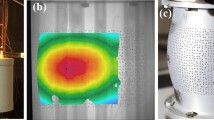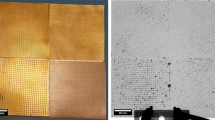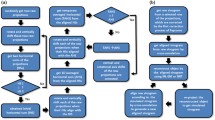Abstract
X-rays can provide images when an object is visibly obstructed, allowing for motion measurements via x-ray digital image correlation (DIC). However, x-ray images are path-integrated and contain data for all objects between the source and detector. If multiple objects are present in the x-ray path, conventional DIC algorithms may fail to correlate the x-ray images. A new DIC algorithm called path-integrated (PI)-DIC addresses this issue by reformulating the matching criterion for DIC to account for multiple, independently-moving objects. PI-DIC requires a set of reference x-ray images of each independent object. However, due to experimental constraints, such reference images might not be obtainable from the experiment. This work focuses on the reliability of synthetically-generated reference images, in such cases. A simplified exemplar is used for demonstration purposes, consisting of two aluminum plates with tantalum x-ray DIC patterns undergoing independent rigid translations. Synthetic reference images based on the “as-designed” DIC patterns were generated. However, PI-DIC with the synthetic images suffered some biases due to manufacturing defects of the patterns. A systematic study of seven identified defect types found that an incorrect feature diameter was the most influential defect. Synthetic images were re-generated with the corrected feature diameter, and PI-DIC errors were improved by a factor of 3-4. Final biases ranged from 0.00-0.04 px, and standard uncertainties ranged from 0.06-0.11 px. In conclusion, PI-DIC accurately measured the independent displacement of two plates from a single series of path-integrated x-ray images using synthetically-generated reference images, and the methods and conclusions derived here can be extended to more generalized cases involving stereo PI-DIC for arbitrary specimen geometry and motion. This work thus extends the application space of x-ray imaging for full-field DIC measurements of multiple surfaces or objects in extreme environments where optical DIC is not possible.





Similar content being viewed by others
Notes
Equation (1) invokes several simplifying assumptions, including: (1) a monochromatic x-ray source (rather than the common polychromatic lab sources) is used; (2) the detector image intensity is linearly proportional to the x-ray intensity; (3) attenuation of the x-rays due to air is negligible compared to the attenuation due to the plate and feature materials; (4) the change in image intensity due to the emittance angle from a conical x-ray beam is negligible; (5) spatial variations of the x-ray and/or image intensity are corrected during image preprocessing. See [17] for more details.
The displacements of the two individual plates are computed in a Lagrangian framework for a single plate at a time. For brevity, the algorithm is explained here for tracking the front plate displacement. However, by reversing references to the “front plate” and “back plate”, a similar analysis of the back plate can be performed.
References
Sutton MA, Orteu J-J, Schreier H (2009) Image correlation for shape, motion and deformation measurements: basic concepts, theory and applications, volume 1. Springer
Lucas BD, Kanade T (1981) An iterative image registration technique with an application to stereo vision. In: IJCAI’81: 7th international joint conference on artificial intelligence, vol 2, pp 674–679
Delmas A, Maoult YL, Buchlin J-M, Sentenac T, Orteu J-J (2013) Shape distortions induced by convective effect on hot object in visible, near infrared and infrared bands. Exp Fluids 54:1–16
Jones EMC, Reu PL (2018) Distortion of digital image correlation (DIC) displacements and strains from heat waves. Exp Mech 58(7):1133–1156
Lyons JS, Liu J, Sutton MA (1996) High-temperature deformation measurements using digital-image correlation. Exp Mech 36:64–70
Lynch KP, Jones EMC, Wagner JL (2020) High-precision digital image correlation for investigation of fluid-structure interactions in a shock tube. Exp Mech 60:1119–1133
AW Murphy, ET Zepper, EMC Jones, EC Quintana, MM Montoya, AA Cruz-Cabrera, SN Scott, and BC Houchens. Response of aluminum-skinned carbon-fiber-epoxy to heating by an adjacent fire, 2021. 12th U.S. National Combustion Meeting, Organized by the Central States Section of the Combustion Institute, College Station, TX
Rae PJ, Williamson DM, Addiss J (2011) A comparison of 3 digital image correlation techniques on necessarily suboptimal random patterns recorded by x-ray. Exp Mech 51:467–477
Russell SS, Sutton MA (1989) Strain-field analysis acquired through correlation of x-ray radiographs of a fiber-reinforced composite laminate. Exp Mech 29:237–240
Prentice HJ, Proud WG, Walley SM, Field JE (2010) The use of digital speckle radiography to study the ballistic deformation of a polymer bonded sugar (an explosive simulant). Int J Impact Eng 37(11):1113–1120
Synnergren P, Goldrein HT, Proud WG (1999) Application of digital speckle photography to flash x-ray studies of internal deformation fields in impact experiments. Appl Opt 38(19):4030–4036
Grantham SG, Goldrein HT, Proud WG, Field JE (2003) Digital speckle radiography-a new ballistic measurement technique. Imaging Sci J 51(3):175–186
Synnergren P, Goldrein HT (1999) Dynamic measurements of internal three-dimensional displacement fields with digital speckle photography and flash x rays. Appl Opt 38(28):5956–5961
Jones EMC, Quintana EC, Reu PL, Wagner JL (2020) X-ray stereo digital image correlation. Exp Tech 44:159–174
James JW, Jones EMC, Quintana EC, Lynch KP, Halls BR, Wagner JL (2022) High-speed x-ray stereo digital image correlation in a shock tube. Exp Tech 46(6):1061–1068
EMC Jones (2023) Path-integrated stereo x-ray digital image correlation: Resolving the violation of conservation of intensity. Exp Mech. https://doi.org/10.1007/s11340-023-01029-7
Jones EMC, Fayad SS, Quintana EC, Halls BR, Winters C (2023) Path-integrated x-ray images for multi-surface digital image correlation (PI-DIC). Exp Mech 63(4):681–701
Swinehart DF (1962) The Beer-Lambert law. J Chem Educ 39(7):333
Jackson DF, Hawkes DJ (1981) X-ray attenuation coefficients of elements and mixtures. Phys Rep 70(3):169–233
Lava P, Jones EMC, Wittevrongel L, Pierron F (2020) Validation of finite-element models using full-field experimental data: levelling finite-element analysis data through a digital image correlation engine. Strain 56(4):e12350
Shi Y, Blaysat B, Chanal H, Grédiac M (2023) Introducing virtual DIC to remove interpolation bias and process optimal patterns. Exp Mech 1–17
Poludniowski G, Omar A, Bujila R, Andreo P (2021) Spekpy v2. 0-a software toolkit for modeling x-ray tube spectra. Med Phys 48(7):3630–3637
Hubbell JH, Seltzer SM (2016) X-ray mass attenuation coefficients: NIST standard reference database 126. Actual website: https://www.nist.gov/pml/x-ray-mass-attenuation-coefficients
Duan X, Wang J, Yu L, Leng S, McCollough CH (2011) CT scanner x-ray spectrum estimation from transmission measurements. Med Phys 38(2):993–997
Marinovszki Á, De Beenhouwer J, Sijbers J (2018) An efficient CAD projector for x-ray projection based 3D inspection with the ASTRA toolbox. In: Proceedings of the 8th Conference on Industrial Computed Tomography (iCT 2018), Wels, Austria, pp 1–6
Reu PL (2011) Experimental and numerical methods for exact subpixel shifting. Exp Mech 51:443–452
Joint Committee for Guides in Metrology (JCGM) (2007) International vocabulary of basic and general terms in metrology (VIM). JCGM 200:2007(E). Available online: https://www.iso.org/sites/JCGM/VIM-introduction.htm. Accessed 12 Dec 2022
Reu PL, Blaysat B, Andò E, Bhattacharya K, Couture C, Couty V, Deb D, Fayad SS, Iadicola MA, Jaminion S et al (2022) DIC challenge 2.0: developing images and guidelines for evaluating accuracy and resolution of 2D analyses: focus on the metrological efficiency indicator. Exp Mech 62(4):639–654
International Digital Image Correlation Society, Jones EMC, Iadicola MA (2018) A good practices guide for digital image correlation. 1 edition. https://doi.org/10.32720/idics/gpg.ed1
Acknowledgements
The authors would like to acknowledge Andrew Lentfer for his work setting up and training the team on the x-ray imaging system, Dayna Obenauf for her contribution in the planning and execution of the plate translation experiments, and John Miers for internal peer-review.
Funding
This article has been authored by an employee of National Technology and Engineering Solutions of Sandia, LLC under Contract No. DE-NA0003525 with the U.S. Department of Energy (DOE). The employee owns all right, title and interest in and to the article and is solely responsible for its contents. The United States Government retains and the publisher, by accepting the article for publication, acknowledges that the United States Government retains a non-exclusive, paid-up, irrevocable, world-wide license to publish or reproduce the published form of this article or allow others to do so, for United States Government purposes. The DOE will provide public access to these results of federally sponsored research in accordance with the DOE Public Access Plan at https://www.energy.gov/downloads/doe-public-access-plan. This paper describes objective technical results and analysis. Any subjective views or opinions that might be expressed in the paper do not necessarily represent the views of the U.S. Department of Energy or the United States Government. Sandia National Laboratories is a multimission laboratory managed and operated by National Technology & Engineering Solutions of Sandia, LLC, a wholly owned subsidiary of Honeywell International, Inc., for the U.S. Department of Energy’s National Nuclear Security Administration under contract DE-NA0003525
Author information
Authors and Affiliations
Contributions
Author contributions are recognized using the Contributor Roles Taxonomy (CRediT), https://doi.org/10.1002/leap.1210. Samuel S. Fayad: Methodology; Software; Data Curation; Investigation; Validation; Formal Analysis; Visualization; Writing—Original Draft; Writing—Review & Editing Elizabeth M. C. Jones: Methodology; Software; Data Curation; Writing—Review & Editing; Supervision; Conceptualization; Resources Caroline Winters: Writing - Review & Editing; Funding Acquisition; Project Administration; Resources
Corresponding author
Ethics declarations
Conflict of Interest
Caroline Winters is a technical editor for Experimental Techniques.
Additional information
Publisher's Note
Springer Nature remains neutral with regard to jurisdictional claims in published maps and institutional affiliations.
E.M.C. Jones and C. Winters are members of SEM.
Supplementary Information
Below is the link to the electronic supplementary material.
Rights and permissions
Springer Nature or its licensor (e.g. a society or other partner) holds exclusive rights to this article under a publishing agreement with the author(s) or other rightsholder(s); author self-archiving of the accepted manuscript version of this article is solely governed by the terms of such publishing agreement and applicable law.
About this article
Cite this article
Fayad, S.S., Jones, E. & Winters, C. Path-Integrated X-Ray Digital Image Correlation using Synthetic Reference Images. Exp Tech (2024). https://doi.org/10.1007/s40799-024-00707-y
Received:
Accepted:
Published:
DOI: https://doi.org/10.1007/s40799-024-00707-y




